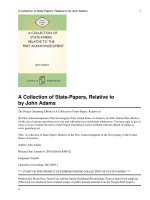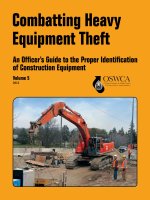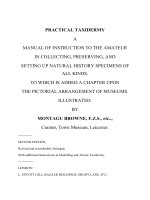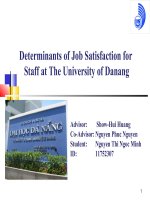Antecedents of employees loyalty to the organization through the mediating role of job satisfaction
Bạn đang xem bản rút gọn của tài liệu. Xem và tải ngay bản đầy đủ của tài liệu tại đây (957.49 KB, 83 trang )
UNIVERSITY OF ECONOMICS HO CHI MINH CITY
International School of Business
------------------------------
LE ANH HUNG
ANTECEDENTS OF EMPLOYEES' LOYALTY TO THE
ORGANIZATION THROUGH THE MEDIATING ROLE
OF JOB SATISFACTION
ID: 22120125
MASTER OF BUSINESS (Honours)
SUPERVISOR: DR. PHAM QUOC HUNG
Ho Chi Minh City - Year 2015
i
Acknowledgements
Firstly, I would like to express deep gratitude to my supervisor who has given me
great supervision and advice in this process. His feedback and guidance as well as
knowledge in this field were very valuable and useful throughout the all process of
research.
Secondly, I have a high grateful to all respondents who spent their valuable time to
answer my questionnaire. Especially, I feel many thanks by my support of friend who
delivered my questionnaires to others and helped me collect data as well as assisted many
sources for my task.
Thirdly, I express my gratitude to my colleague at AMECO. Ltd, they assumed my
work when I must have finished every stage of this research.
At last, my sincere thanks owe to my family who supported me both of physical
and mental conditions to complete this study.
July 01, 2015.
Le Anh Hung
ii
ABSTRACT
Labor force is a vital factor to contribute the successful of organization. But
retention of loyalty employees are challenging. The purpose of the study is to determine
the factors impact on the employee loyalty. The research model included dependent
variable "employee loyalty" and mediator variable "employee satisfaction" as well as four
independent variables, namely: relationship with immediate supervisor, supportive
management style, training and honest communication. It means that the study carried out
to know how the impact of independent variables on employee loyalty and employee
satisfaction. Secondly, this study is also find out how the relationship between employee
satisfaction and employee loyalty. The research used the quantitative approach to collect
data. Data was collected from 350 employees who worked for five companies at Ho Chi
Minh city, Dong Nai province, Vung Tau and Binh Duong Province.
In data analysis, the result showed that independent variables has impact on
dependent variable. For example: relationship with immediate supervisor, training and
honest communication had impact on employee satisfaction. Secondly, relationship with
immediate supervisor, training and honest communication had impact on employee
loyalty. That is a pity, there was not relationship between employee satisfaction and
employee loyalty.
Moreover, the research had some of hypothesis that satisfied. So, the model
research had some change. Based on the research result, it will suggest manager
understand the relationship between employer and employee, deeply.
KEYWORDS: Relationship with immediate supervisor, supportive management
style, training and honest communication, employee satisfaction and employee loyalty.
iii
Contents
Acknowledgements .......................................................................................................... i
ABSTRACT .................................................................................................................... ii
LIST OF TABLES .......................................................................................................... v
LIST OF FIGURES ......................................................................................................... v
LIST OF ABBRVATION .............................................................................................. vii
CHAPTER 1: INTRODUCTION .................................................................................... 1
1.1. Background. ............................................................................................................. 1
1.2. Statement of the problem. ......................................................................................... 3
1.3. Research objectives................................................................................................... 4
1.5. The Scope and Limitation. ........................................................................................ 4
1.6. Chapter Layout. ........................................................................................................ 5
1.7. Chapter summary. ..................................................................................................... 5
CHAPTER 2: LITERATURE REVIEW AND HYPOTHESIS DEVELOPMENTS. ....... 7
2.1. Theoretical background. ........................................................................................... 7
2.1.1. Employee Loyalty. ............................................................................................. 8
2.1.2. Employee satisfaction. ........................................................................................ 9
2.1.3.Factors affecting both employee satisfaction and employee loyalty . ................. 10
2.1.4.Impact of Employee satisfaction toward loyalty................................................. 15
2.2. Research Model. ..................................................................................................... 16
2.3. Chapter summary. ................................................................................................... 18
CHAPTER 3: RESEARCH METHODOLOGY.............................................................. 19
3.1. Research method and procedure.............................................................................. 19
3.2. Measurement scales. ............................................................................................... 21
3.2.1. Employee Loyalty. ........................................................................................... 21
3.2.2. Employee Satisfaction. ..................................................................................... 21
3.2.3. Relationship with immediate supervisor. .......................................................... 22
3.2.4. Training. ........................................................................................................... 23
3.2.5. Supportive management style. .......................................................................... 24
iv
3.2.6. Honest communication. .................................................................................... 25
3.3. Main survey. ........................................................................................................... 26
3.4. Sampling................................................................................................................. 27
3.5.Data analysis method. .............................................................................................. 27
3.6.Chapter summary ..................................................................................................... 29
CHAPTER 4: DATA ANALYSIS ................................................................................. 29
4.1. Descriptive Analysis. .............................................................................................. 30
4.2. Scale measurement. ................................................................................................ 31
4.3. Correlations coefficient. .......................................................................................... 34
4.4. Confirmatory Factor Analysis (CFA). .................................................................... 35
4.5. Multiple Regression Analysis. ................................................................................ 37
4.6. Chapter Summary ................................................................................................... 41
CHAPTER 5: DISCUSSION ......................................................................................... 42
5.1. Conclusion. ............................................................................................................. 42
5.2. Contributions and implications ............................................................................... 43
5.3. Limitations.............................................................................................................. 44
5.4. Recommendations for the future research. .............................................................. 44
References ..................................................................................................................... 45
APPENDICES ............................................................................................................... 53
Appendix 1: English Questionnaire. .............................................................................. 53
Appendix 2: Vietnamese Questionnaire. ........................................................................ 54
Appendix 3: Result of the descriptive analysis. .............................................................. 55
Appendix 4: Result of the reliability test. ....................................................................... 58
Appendix 5: Pearson correlation Coefficient.................................................................. 60
Appendix 6: Result of CFA ........................................................................................... 61
Appendix 7: Result of multiple regression analysis. ....................................................... 68
v
LIST OF TABLES
Table 4.1.1: Gender of respondent.................................................................................24
Table 3.1: Scales items for employee loyalty.................................................................32
Table 3.2: Scales items for employee satisfaction..........................................................33
Table 3.3: Scales items for relationship with immediate supervisor..............................33
Table 3.4: Scales items for training................................................................................34
Table 3.5: Scales items for supportive management style..............................................35
Table 3.6: Scales items for honest communication.........................................................36
Table 3.7: Main measure of CFA....................................................................................39
Table 4.1: Characteristic of Sample.................................................................................42
Table 4.2: Result of reliability test.................................................................................44
Table 4.3: Pearson correlation Coefficient......................................................................45
Table 4.4: Validity and Reliability..................................................................................47
Table 4.5: Model Summaryb...........................................................................................48
Table 4. 6: ANOVAa.......................................................................................................48
Table 4.7: Coefficientsa...................................................................................................49
Table 4.8: Model Summaryb...........................................................................................50
Table 4.9: ANOVAa........................................................................................................50
Table 4.10: Coefficientsa.................................................................................................51
vi
LIST OF FIGURES
Figure 2.1: Research Model...........................................................................................29
Figure 3.1: The research process....................................................................................31
Figure 4.1: Amos Model................................................................................................46
vii
LIST OF ABBRVATION
WTO : WORRLD TRADE ORGANNIZATION
APEC : ASIA-PACIFIC ECONOMIC COOPERATION
AFTA : ASEAN FREE TRADE AREA
ASEM : THE ASIA-EUROPE MEETING
VAM : VIET NAM ASSOCIATION OF MECHANICAL INDUSTRY
CFA :
CONFIRMATORY FACTOR ANALYSIS
1
CHAPTER 1: INTRODUCTION
1.1. Background.
In the 21 century, the countries undergo many huge problems in the world. One of
them was financial issue. Caudron (as cited in Kelli, 2001) agreed that there have been
many companies that are downsizing due to slow periods in recent years. Viet Nam is
also affected more or less. Simultaneously ,Viet Nam is affected by financial crisis storm
and Economic recession from 2008. It took many people to lose job, companies were
bankruptcy. In 2012, there were 54.261 dissolution enterprises (Xuan Than, 2013), it
increased 60.737 by 2013 ( Thanh Trung, 2014). It jumped 67.823 enterprise in 2014
(Trung Ninh, 2014).
Viet Nam Joins the WTO and APEC which made trade more dynamic. Thus, it
excited domestic firms more and more interested. Enterprise want to improve their
competitiveness in order to occupy the market. Enterprise should update many things to
respond real situation. For example management systems, business strategy, human
resource management, financial management, internal controls .... Tran Van Hung.
(2011a) stated that Conditions created a competitive advantage that was investment and
development of human resources with high quality.
Thereby, this study only focused on human resource management field. Human
management is an important aspect of organizational processes. A well-managed
business organization normally considers the employees as the primary source of
productivity gains. These organizations consider employees rather than capital as the core
foundation of the business and contributors to develop firm. To ensure the achievement
of firm goals, the organization creates an atmosphere of commitment and cooperation for
its employees through policies that facilitate employee satisfaction. Satisfaction of human
2
resource finds close links to highly motivated employees. Motivating employees and
developing loyalty or commitment to increase productivity and reduce turnover rates.
Frederick. F (2001) referred that "Loyalty is the key to success in today's
economy"(p. 01).Loyalty will be defined as the tendency of an employee to continue
working for the same employer. Nighat Naeem (2013) stated that" Employee satisfaction
is one of the main and important issues of all time..... Employees are the key player in
organization so their commitment with organization is very important"(p. 01).
To get more achieving in the world market and domestic market is becoming an
difficult more than it has been ever. Hence, maintaining the stable labor force is very
important of enterprise which is also unvalued asset."Employees are more loyal and
productive when they are satisfied" ( Hunter & Tietyen, as cited in Bulent Aydin &
Adnan Cevlan, 2008, p.4). The purpose of this study is to examine the relationship
between employee loyalty and employee satisfaction. The study also find out the impact
of other factor toward employee loyalty with employee satisfaction. Such as relationship
with immediately supervisor, training program, supportive management style and honest
communication.
The research only discover in Engineering company because there are following
reason .Firstly, mechanical engineering is one in eight key industry at Vietnam.
Engineering industrial is a brand of economic that has particularly important position for
the development of the economy because it is a produce industry which creates
machinery and equipment supply for the other industry. In fact, the world does not has
any country to implement the successful of industrialization and modernization process
so that does not has a strong mechanical industry, the development of mechanical
industry is both foundation and driving for the development of the different professions
in society, it also has a positive impact on the services sector through the development of
the distribution network. Secondly, researcher want to interest in mechanical engineering.
Because researcher passion this field so long.
3
1.2. Statement of the problem.
Viet Nam is entering the economic integration process. Viet nam joined some
economic organization. Such as WTO, AFTA, ASEM, APEC...So the enterprise had not
only opportunities but also challenges. The mechanical engineering was belong to
important development program of government which did not avoid difficult and
challenges. Next, I list some following difficult. For example: lack of capital, model
equipment, high qualified manpower.
According to Doanh nghiep co khi va doi song magazine, Mr Nguyen Van Thu
who is president of VAMI. he said that the criterions to develop mechanical engineering,
firstly, reducing the lack of capital. Secondly, increasing the qualified staff. Lastly,
government has appropriate policies (Hoang Son, 2014). Tran Anh Tuan was deputy
president of Trung tam du bao nguon nhan luc va thi truong lao dong TpHCM who talked
about the candidate registered to study the social and technical sector less than economic
sector. So, this lead to lack the human resource in this sector (Hội thảo tập huấn nghiệp
vụ tư vấn hướng nghiệp và tuyển sinh ĐH – CĐ, 2013).Tran Van Hung (2011b) said that
the high quality workforce will continue to be a shortage and scarcity in some areas such
as mechanical engineering, automation, atomic physics, the international trade business,
accounting and auditing, bank.
Initially, human resources was the main problem in many field that included
mechanical engineering. Secondly, labor force supplied low quantity and quality. Thirdly,
skilled employees had low quantity. if they would have low loyalty, they can give up
present job to find out new job in high benefit. Hence, to investigate factors affecting
towards employee loyalty and satisfaction which is necessary. It suggest manager know
how to understand employee and how to retain stable workforce. The matters will
contribute the development during the economic integration with industrialization and
4
modernization. Hereby, this study want to investigate factors affecting towards employee
loyalty and satisfaction in the mechanical engineering
1.3. Research objectives.
The aim of this study is to identify factors affecting the employee loyalty which
will be divided three specific purpose below:
1. To investigate factors impact towards employee loyalty. Such as relationship
with immediately supervisor, training, supported management style, honest
communication and employee satisfaction
2. To evaluate the relationship between employee satisfaction and employee
loyalty.
3. To investigate factors impact towards employee satisfaction. Such as
relationship with immediately supervisor, training, supported management style, honest
communication 1.4.Significance.
It is very essentials to do this research because it give many benefit. Firstly, this
study tried to find the factors impacted on employee loyalty and employee satisfaction.
Secondly, these results help manager know how to improve a satisfaction and loyalty
their employee. In addition, this is basic research in order to do more survey in future. At
last, this study is fulfilled in economic integration so it becomes more important because
of retaining and developing human resource is very crucial matter.
1.5. The Scope and Limitation.
The study only survey employees who are working for engineering company. In
addition, the study will use quantitative method to collect and process the data.
5
The limitation of this study is a sample size which is collected some organizations
in Binh Duong, Dong Nai, Vung Tau province and Ho Chi Minh City. Thus the reality of
results will change if the survey is done in widen places.
1.6. Chapter Layout.
This research was written in five chapters below:
Chapter 1: Introduction: This part gave an overall review of entire research; a brief
background of the research. Another item had the problem statement and the research
objectives.
Chapter 2: Literature Review: This chapter is heavily which contain the reviews of
the various literature and previous studies. It related to this research topic. It contains the
discussion of the various articles, journals and research studies. One will divide into four
parts which are theoretical background of the conceptual framework, hypothesis
development and research model.
Chapter 3: Research Methodology: This chapter focus on discussion of research
method where it describe the procedure of how the research carry out in terms of the
research design and setting, data collection method, sampling design, measurement scales
and data analysis method.
Chapter 4: Data Result: This part includes the overall result and analysis of
questionnaire . The result will be present in chart and table.
Chapter 5: Conclusion: This chapter will not only discuss the overall of descriptive
and analyses from previous chapter, but also suggest the major finding. Lastly, the
limitation of study and recommendation will be presented for future research.
1.7. Chapter summary.
This Chapter constructed in seven part. Namely research background, research
problems, research objectives , research contributions, the scope and limitation, research
6
structure and chapter summary. A research background and problem statement help
readers to understand and to get basic knowledge about the research. Secondly, the
research objectives and research questions determine purpose of study. Next, the scope
and limitation specify area to find out. finally, the research chapter gave structure of the
research. The next chapter is the literature and studies review .
7
CHAPTER 2: LITERATURE REVIEW AND HYPOTHESIS DEVELOPMENTS
This chapter provides literature review where it used to the theories and the
information. Text was extracted from journals, articles, newspapers that mentioned each
factor in the model. In short, this information of chapter is all secondary sources. This
chapter divide into two parts which are theoretical background and research model.
2.1. Theoretical background.
Employee loyalty is a matter which has wide interest by people who manage in
organization and people who study them. Engaging employees do the better jobs which is
essential for success organization in long term. Employee loyalty always identify through
satisfaction factor. Up to now, Employee satisfaction has closely related with more
organization.
In 1944 Abraham Maslow ,who was an American psychologist , wrote a " theory
of human motivation". It included five level from low to high stage. For employee
satisfaction in the workplace , some scholars have adopted Maslow's theory and used his
notion of need fulfillment to measure this factor.
There are many study which reflects many aspect of employee loyalty. Here,
research gives some relevant research.
Firstly, Turkyilmaz et al. (2011a) wrote in" Empirical study of public sector
employee loyalty and satisfaction". It measured loyalty variable by satisfaction which
was affected empowerment and participation, working conditions, reward and
recognition, teamwork, training and individual development. Secondly, Edward (1975)
showed that " factor affecting employee loyalty by which used model including job
satisfaction, Internal forces and external forces" (p. 1). Finally, Mohd et al. (2009) found
that " an empirical investigation into the influences of psychological empowerment and
8
overall job satisfaction on employee loyalty: the case of Malaysian front office
receptionists" (p. 1).which suggested the model include employee psychological
empowerment and job satisfaction also affect on employee loyalty.
On this study has significant differences that is dependent variable will affect
independent variables. It will present below:
This section shows in three parts. Firstly, the definition of employee satisfaction
with employee loyalty was introduced. Next, the factors impact both employee loyalty
and employee satisfaction. Finally, representing the relationship between employee
satisfaction and employee loyalty.
2.1.1. Employee Loyalty.
Loyalty is a feeling which orientation of employees want to relate with future
direction and development of the company. In practice. It sometimes happens that an
individual, who is satisfied with his or her work, will not belong to the organization or
team. Because of his or her characteristic.
"Many firm perceive employees as an asset of the company and employee loyalty
has become as important of an issue as customer loyalty in business industry. Even
though companies have been striving to provide better support or opportunities to
employees , they have been faced with difficulty in keeping employees in
organization"(Voyles, as cited in Lee, 2000a, p. 32)
Drizin and schneider (2004) stated that loyalty employees tended to commit and
stay in the organization and were willing to help the company irrespective of their job
assignments and descriptions (as cited in Lee, 2000b). Organizational loyalty of
employees could be defined as " the relative strength of an individual's identification with
9
and involvement in a particular organization" ( Wu and Norman, as cited in Turkyilmaz
et al., 2011b, p. 8)
Thus, loyalty is characterized by the strong wish to continue membership of an
organization which plays a positive role in retention of members in the organization.
2.1.2. Employee satisfaction.
The level of Employee satisfaction is a concept reflecting the degree to which the
individual's needs and desire was received. Researchers gave a lot of definition about
employee satisfaction.
"Employee satisfaction is the terminology used to describe whether employees are
happy, contended and fulfilling their desires and needs at work. Many measures
support that employee satisfaction is a factor in employee motivation, employee
goal achievement and positive employee morale in the work place"( Heathfieth,
M, as cited in Sageer et al, 2012a, p. 01 ).
Cranny, Smith and Stone (1992) defined that "employee satisfaction as the
combination of a affective reactions to the differential perceptions of what he/she wants
to receive compared with he/she actually receives"(as cited in Sageer et al, 2012b, p. 01).
Moyes, Shao and Newsome (2008) defined that " the employee satisfaction may be
described as how pleased an employee to with his or her position of employment" (as
cited in Sageer et al, 2012c, p. 01).
10
2.1.3. Factors affecting both employee satisfaction and employee loyalty .
2.1.3.1. Relationship with immediate supervisor.
"Immediate supervisors act as advocates for employees, gathering and distributing
the resources needed by the employees for them to be able to do a good job and providing
positive encouragement for a job well done" (Chandrasekar, 2011, p. 6). kee et al.
(2012a) defined that the relationship with supervisor can be formed through two way
communication. The supervisor plays an important role in relationship, because they
monitor the employee’s performance and lead them toward goal achievement.
To evaluate the impact of relationship with immediate supervisor into employee
satisfaction and employee loyalty. The previous researchers gave many theory to support
this matter. Ami et al (2012) stated that " I will give many factor affecting the employee
satisfaction. such as Relationship with immediate supervisor" (p, 3). Sageer et al, (2012d)
showed that variables on which employee satisfaction depends promotion and career
development, relationship with immediately supervisor.....
In another definition, a good relationship between worker and their immediate
supervisor is very important since both work in the same organization and share the same
workplace (sturgeon, as cited in kee et al, 2012b). Kee Hui Poo et. at, (2012c) showed
that there is positive relationship between relationship with supervisor and employee
loyalty.
Therefore. I suggested two hypothesis that relate with purpose of thesis below.
H1: Relationship with immediate supervisor has a positive impact on employee
satisfaction.
H2: Relationship with immediate supervisor has a positive impact on employee loyalty
2.1.3.2. Training.
Noe (2002) defined that training as planned activities to increase the job
knowledge and skills or to modify the attitudes and behaviors of employees in order to
11
make them consistent with the goals of the organization and the requirements of the job.
Employee training provides opportunities to employees widen their knowledge and
abilities for more efficient teamwork and achieve individual development (Jun et al.,
2006).
Training has impact the aspects of life. So, it was researched very deep to apply .
this study suggest several theory about training which has impact into both employee
satisfaction and employee loyalty. When workers receive self-development training, the
level of their job satisfaction is higher than those without such training (Chang et al.,
2010). Also, Herzberg (1968) found that employee job satisfaction is influenced when
they have an opportunity for advancement of individual competencies through various
training programs. When employees attended to training programs, they gain selfconfidence of making their jobs, they perceive career development opportunities and they
think that their companies make investment in them (Jun et al., 2006). As result of this
positive situations, employee satisfaction increases gradually.
Martensen and Gronholt (2001) found that through various training program has a
positive influence on employee satisfaction. (as cited in Turkyilmazet al., 2011c).
Bradley, Petrescu and Simmons (2004) explain that creating on- going learning as well as
training in workplace has a highly significant effect on job satisfaction. (as cited in
Boyad, 2012a)
Bariha Batool said that Employee training remains one of the widely driven forces
toward job satisfaction (2012a, p. 2). Higher degree of training increases employee
satisfaction and loyalty towards the firm and decreases the chances of employee
termination and lay-offs (Choo and Bowley, as cited in Batool et al, 2012b). Solomon
(1992) described factors that can influence employee loyalty and retention. such as a
training opportunities to learn more knowledge and skills (as cited in Lee, S. S. 2008c).
Training, employee empowerment and rewards leads to high performance work
practices at workplace and help retain employees (Osman M. Karatepe 2013). This leads
to the following hypotheses.
12
H3: Training has a positive impact on employee satisfaction .
H4: Training has a positive impact on employee loyalty.
2.1.3.3. Supportive management style.
On the research paper "A relational study on service climate, supportive
management, work effort, job satisfaction and employee service quality in the context of
real estate sector of Bangladesh". Alamgir (2011)found that Supportive management
refers to managers‟ concerns and support for subordinates‟ work and represents the
degree to which they create a facilitative climate of support, trust, and helpfulness.
According to Muller et al. (2009), Supportive leadership is defined as "attitudes,
communication, behaviours and actions by managers and supervisors that enable staff to
feel supported thereby to work effectively, productively and appropriately".(p. 5).So.
Supportive management refer to manager who concern and support for subordinates.
Support is a form which work will instruct gradually until somebody can do it
themselves. and add activities to help employee in everyday life.
As supervisor take care to help and support the contact employees and are
concerned about their needs, these employees will feel more satisfied (Griffin, Patterson
& West, 2001). Such supervisor supportive behavior has been found to be related to
employee job satisfaction. The previous research examined the relationships between
supervisor support and job satisfaction and reported a positive relationship between
supervisor support and job satisfaction (Chang et al., 2010)
Organizational commitment has been defined as the relative strength of an
employee's identification and involvement with a particular organization (Steers, 1977).
In the other journal " A path analytic study of the antecedents of organizational
commitment of IS managers", Tu et al. (2001) referred that theories about organizational
Commitment and supportive managerial. Namely: Organizational
Commitment: the degree of an individual's willingness to stay or propensity to leave his
13
or her organization. It includes a strong belief in and acceptance of the organization's
goals and values, a willingness to exert considerable effort on behalf of the organization,
and a definite and strong desire to maintain membership in the organization (Mowday et
al., 1982). longitudinal study by Majchrzak and Cotton (1988) also verified that
supportive managerial environment has significant positive impact on
individuals' organizational commitment.
In the other results, Thoits ( as cited Alamgir, 2011) said that a supportive
environment such as boss support would commitment, reduce turnover intentions, and
enhance performance. Supportive management style: Employee empowerment practices
positively affect employee satisfaction ( Voisard, 2008; Dewettinck et. al., 2003;
Halvorsen, 2005; Kirkmanad Rosen, 1999. as cited in Boyad, 2012b). Roehling et al
(2001) revealed that supervisor support has highly influence in employee loyalty.
Therefore, I can hypothesize that:
H5: Supportive management style has a positive impact on employee satisfaction.
H6: Supportive management style has a positive impact on employee loyalty.
2.1.3.4. Honest communication.
Previous researchers explained definition of communication follow. Such as: A
popular view of communication is that it is the process by which information about
policies, procedures, finance and customer feedback is conveyed to
others in organizations.(Vandenberg et al. ,as cited Bambacas, M., & Patrickson, M.
2008). Ronald Gross said that Communication is the lifeblood of any organization, big or
small (as cited Wessel, H. (2003). Williams, B. L. (2006) defined that. Communication
plays a major role in helping managers acquire, retain, and use knowledge in the
workplace, which in turn assists them in accomplishing their various work-related goals.
14
In the other definition, Internal communication is operationally defined as the
exchange of information both informal and formal between management and employees
within the organization. Communications are operationally defined as technology and
systems used for sending and receiving messages. Communications may include
newsletter, circulation materials, surveys, emails, suggestion boxes etc. Organizational
communication focuses on connecting individual employees, groups and organization as
a whole to facilitate realization of common interest and spontaneous cooperation (A.S.
Hatch 1964). According to De Ridder (2004), 0rganisational communication is
instrumental in facilitating supportive employees. Finally, newspaper was" Open and
honest communication job coach" which defined that honest communication is formed of
open communication in which everyone provide input and get feedback more effectively
and efficiently. (2007)
Thus, Organization communication connects individual employees, group and
organization. In life, one is a heart of every relationship and the honest and open
communication is the way that people can create and maintain relationships. In the
workplace, everyone do not only work but also another activities. Specific,
communication which helps people discuss about work, change their experience...it
creates relationship together. So, communication has a signification factor to build the
cultural of organization.
Boyad et al (2012c) stated that honest communication is one factor that impact to
employee satisfaction. Morrall (1999b) said that honest communication is an essential
factor between employee and employer and it is critical in building loyalty.
The part of honest communication is critical to building cultural and loyalty. So, I
give some assumption below.
H7: Honest communication has a positive impact on employee satisfaction.
H8: Honest communication has a positive impact on employee loyalty .
15
2.1.4. Impact of Employee satisfaction toward loyalty.
Allen and Grisaffe (2001) demonstrated that "Loyalty is a psychological state and
it characterizes the relationship of an employee with the organization for which they
work and that has implication for their decision to remain with the organization"(as cited
in Turkyilmaz et al., 2011d, p. 8).
In another definition, Mathieu and Zajac (1990) found that " loyalty means as
attachment to the organization that may be considered an emotional response, especially
when an employee believes strongly in organization goals and values has a strong desire
to maintain membership of the organization"(as cited in Turkyilmaz et al., 2011e, p. 8)
Thus, Loyalty is characterized of employee who believe and maintain with
organization
Organizational loyalty of employees could be defined as " the relative strength of
an individual's identification with and involvement in a particular organization" ( Wu
and Norman, as cited in Turkyilmaz et al., 2011f, p. 8)
Martensen and Gronhodt (2001) demonstrated that employee satisfaction is
positively related to employees' loyalty to their companies (as cited in Turkyilmaz et al.,
2011g)
In other definition, Al Aemeri (2000) and Fang (2001) reported that a strong
relationship between organizational loyalty of employees and employee job satisfaction
(as cited in Turkyilmazet al., 2011h)
Turkyilmaz et al. (2011i) showed that there are impact and strong relationship
between employee satisfaction and employee loyalty (p, 9). Wu and Norman( 2006)
showed that Low job satisfaction leads to low loyalty organization (as cited in
Turkyilmaz et al., 2011j).
16
According to the previous study. I am confident to give assumption attachment.
H9: Employee satisfaction has a positive impact on employee loyalty .
2.2. Research Model.
All of hypotheses in this study are summarized as below to be easier to follow the
model:
H1: Relationship with immediate supervisor has a positive impact on employee
satisfaction.
H2: Relationship with immediate supervisor has a positive impact on employee
loyalty .
H3: Training has a positive impact on employee satisfaction .
H4: Training has a positive impact on employee loyalty.
H5: Supportive management style has a positive impact on employee satisfaction.
H6: Supportive management style has a positive impact on employee loyalty.
H7: Honest communication has a positive impact on employee satisfaction.
H8: Honest communication has a positive impact on employee loyalty .
H9: Employee satisfaction has a positive impact on employee loyalty .
17
In summary, this chapter presents literature review of each concept each factor,
including independent variables, mediating variable and dependent variable, and six
hypotheses for whole.
The model of this study is represented as below:
Figure 2.1: Research Model.
Relationship with
immetiate supervisor
Training
Employee Satisfaction
Supportive management
style
Honest communication
Employee Loyalty









